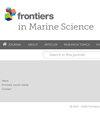使用海洋环流和粒子跟踪模型量化加拿大大西洋水域海洋保护区之间连通性的案例研究
IF 3
2区 生物学
Q1 MARINE & FRESHWATER BIOLOGY
引用次数: 0
摘要
衡量海洋保护区(MPAs)有效性的一个标准是它们在不同生命阶段作为海洋生物源区或汇区的相互关系。在这里,我们使用海洋环流模式ROMS(区域海洋模拟系统),结合海冰模式CICE(社区冰码)和粒子跟踪模式ROMSPath来估计位于加拿大大西洋沿岸的海洋保护区之间的连通性。本研究的重点是被动粒子的连通性(即,粒子的运动是模拟流的平流和代表亚网格尺度环流特征影响的小的随机运动的总和)。使用ROMS和CICE模拟2015-2018年的日平均三维海洋状态,并将其平均为季节平均值,作为ROMSPath的输入。考虑了三个海洋保护区:圣劳伦斯湾的阿姆萨梅斯银行(BdA),圣劳伦斯湾和斯科舍大陆架之间卡伯特海峡的圣安斯银行(SAB),以及斯科舍大陆架近海边缘的峡谷。在每次实验中,被动颗粒在5 m深度以MPA释放,进入季节性平均三维环流场,并跟踪90天。利用2015-2018年各季节30d、60d和90d后的颗粒分布对实验结果进行评价。结果表明,夏季沙区与沟壑区之间的联系最强,60 d后沙区释放的颗粒中约有11%在沟壑区;冬季沙区和沙壑区次之,90 d后沙区释放的颗粒中约有8%在沟壑区。BdA与沟状海洋保护区之间的联系是微弱的,实验结果的年际变化表明这种微弱的联系受到圣劳伦斯河流量变化的影响。实验结果表明,BdA和SAB海洋保护区可以作为该地区重要商业物种雪蟹幼体的来源区。我们还定性地考察了ROMSPath的水平扩散率(控制粒子的小的、随机的运动)的作用。本文章由计算机程序翻译,如有差异,请以英文原文为准。
A case study in the use of ocean circulation and particle-tracking models to quantify connectivity among Marine Protected Areas in Canadian Atlantic waters
One measure of the effectiveness of Marine Protected Areas (MPAs) is their relationship to each other as source or sink areas of marine organisms at different life stages. Here we use the ocean circulation model ROMS (Regional Ocean Modeling System), coupled to the sea ice model CICE (Community Ice CodE), and the particle-tracking model ROMSPath to estimate connectivity among MPAs located off the Atlantic coast of Canada. The focus of this study is on connectivity in terms of passive particles (i.e. , particles whose movements are sums of advection by simulated currents and small, random movements that represent the effect of sub-grid scale circulation features). ROMS and CICE are used to simulate the daily-mean, three-dimensional (3D) ocean state during 2015–2018, which are averaged into seasonal means and used as inputs for ROMSPath. Three MPAs are considered: Banc-des-Américains (BdA) in the Gulf of St. Lawrence, Saint Anns Bank (SAB) in Cabot Strait between the Gulf of St. Lawrence and the Scotian Shelf, and Gully on the offshore edge of the Scotian Shelf. In each experiment, passive particles are released in an MPA, at the 5-m depth, into a seasonal-mean, 3D circulation field and tracked for 90 days. Particle distributions after 30, 60, and 90 days, composited for each season over 2015–2018, are used to assess the results of the experiments. The results indicate the strongest connection among the MPAs occurs between the SAB and Gully MPAs in the summer, with ~11% of particles released from the former being in the latter after 60 days, followed by BdA and SAB in the winter with ~8% of particles from the former being in the latter after 90 days. Connection between the BdA and Gully MPAs is weak, and year-to-year variability among the experimental results suggests this weak connection is influenced by variability in the St. Lawrence River’s discharge. The experimental results suggest the BdA and SAB MPAs can act as source areas to downstream MPAs for larvae of snow crab, a commercially important species in the region. We also qualitatively examine the role of ROMSPath’s horizontal diffusivity (which controls the particles’ small, random movements).
求助全文
通过发布文献求助,成功后即可免费获取论文全文。
去求助
来源期刊

Frontiers in Marine Science
Agricultural and Biological Sciences-Aquatic Science
CiteScore
5.10
自引率
16.20%
发文量
2443
审稿时长
14 weeks
期刊介绍:
Frontiers in Marine Science publishes rigorously peer-reviewed research that advances our understanding of all aspects of the environment, biology, ecosystem functioning and human interactions with the oceans. Field Chief Editor Carlos M. Duarte at King Abdullah University of Science and Technology Thuwal is supported by an outstanding Editorial Board of international researchers. This multidisciplinary open-access journal is at the forefront of disseminating and communicating scientific knowledge and impactful discoveries to researchers, academics, policy makers and the public worldwide.
With the human population predicted to reach 9 billion people by 2050, it is clear that traditional land resources will not suffice to meet the demand for food or energy, required to support high-quality livelihoods. As a result, the oceans are emerging as a source of untapped assets, with new innovative industries, such as aquaculture, marine biotechnology, marine energy and deep-sea mining growing rapidly under a new era characterized by rapid growth of a blue, ocean-based economy. The sustainability of the blue economy is closely dependent on our knowledge about how to mitigate the impacts of the multiple pressures on the ocean ecosystem associated with the increased scale and diversification of industry operations in the ocean and global human pressures on the environment. Therefore, Frontiers in Marine Science particularly welcomes the communication of research outcomes addressing ocean-based solutions for the emerging challenges, including improved forecasting and observational capacities, understanding biodiversity and ecosystem problems, locally and globally, effective management strategies to maintain ocean health, and an improved capacity to sustainably derive resources from the oceans.
 求助内容:
求助内容: 应助结果提醒方式:
应助结果提醒方式:


